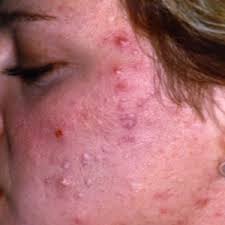Acne inversa
Acne inversa also known as Hidradenitis suppurativa is a
disabilitating chronic inflammatory disease with major negative impact on
quality of life and significant co-morbidities. It usually begins as
pimple-like bumps on the skin. The pimple-like bumps develop in places that
everyday pimples do not appear. It is most common on the underarms and groin.
Acne inversa does not form on the face or back.

If you have this skin disease, you may notice breakouts
on your skin that look like pimples or boils. Your skin may clear for a while,
but you notice new breakouts develop in the same area.
Symptoms start after puberty sometimes with a single bump and can develop
into multiple blackheads, pustules and deep-seated boils that can persist for
years. Other symptoms of acne-inversa include itching, burning and excessive
sweating.
Causes
Acne-inversa develops when
sebaceous glands and hair follicles become blocked with dead skin cells and
sebum. Infection and inflammation caused by bacteria also play a role. dermatologists
don't exactly know what causes the
follicles to become blocked.
The three stages of acne inversa
Stage 1
Stage 1 of acne-inversa
features lesions and sinus tracts, or tunnels, into the skin; there will be
separation between the tunnels. Three-quarters of all acne-inversa cases never
progress beyond this stage.
Stage 2
In Stage 2, the sinus tracts connect to each other, forming a network under the skin. Excess, thickened scar tissue is also present.
Stage 3
In Stage 3, large areas of suppurating, fibrous tissue develop.
Features
The disease starts with
inflammatory, painful nodules and sterile abscesses followed by tissue
fibrosis. It affects at least one percent of the population. Age, gender and
family history are considered the main risk factors responsible for the
disease.
Unlike everyday pimples, acne-inversa (hidradenitis suppurativa) forms in areas where skin touches skin.
It is most common in these areas:
- Underarms
- Groin (genitals, around the anus, and surrounding area)
- Buttocks
- Upper thighs
- Women’s breasts (underneath and sometimes on the breasts)
- Rarely near an ear, around the bellybutton, or on the back of the neck.
- Women tend to get breakouts on their genitals and
upper thighs. Men are more likely to have acne inversa on their genitals and
around the anus.
Treatments
Acne-inversa treatment
depends on the severity of the disease. Each stages have different methods of
treatments. In general, there are three levels in the management of this disease: Topical options, systemic options, and surgical methods, including
laser therapy.
There is no cure for acne-inversa. But early treatment can help manage the symptoms and may prevent new lesions from developing.
Although laser and light
seem to be attractive in controlling the disease, the cure rate is low and the
time needed to improvement is longer. Surgery is a cornerstone for acute
abscess pain relief and for treatment of advanced stage 2 and 3 acne-inversa. Stage
3 often requires wide excision surgery, radiation therapy and skin grafts.
Tags
blackheads, pustules, Topical, laser therapy
Irresistible Acne Remedies. This free newsletter is delivered monthly, straight to your INBOX. It covers all new pages since the last issue. Sign up here...


New! Comments
Have your say about what you just read! Leave me a comment in the box below.